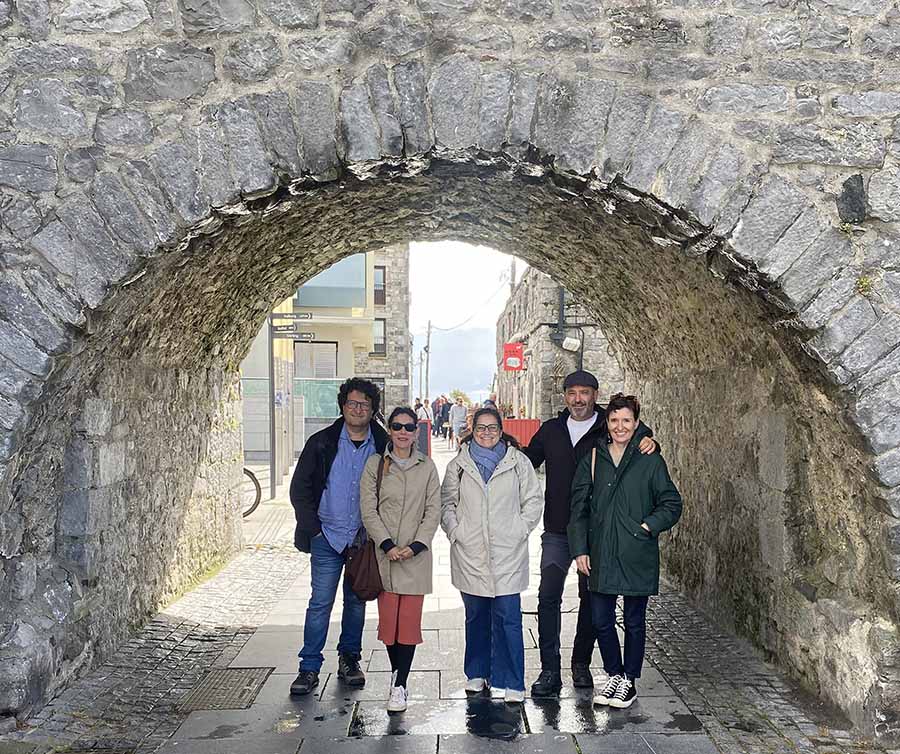
Four Spanish journalists have been exploring the Wild Atlantic Way and Causeway Coastal Route, focusing on Spanish Armada history to inspire Spanish visitors.
The tinerary included Spanish Point and the Cliffs of Moher in County Clare, Galway city, Streedagh Beach and the Spanish Armada Visitor Centre in County Sligo, as well as Glencar Waterfall and Rossclogher Castle. The journalists’ itinerary also took them to the walled city of Derry, the Giant’s Causeway, Dunluce Castle, Titanic Belfast and the Ulster Museum.
Susan Bolger shared: “Tourism Ireland was delighted to invite these influential Spanish journalists to discover our stunning coastline – and, in particular, the history of the Spanish Armada shipwrecks. Their articles and broadcasts will reach over 1m potential Spanish holidaymakers, inspiring them to put Ireland on their holiday ‘wish-list’ and come and explore our beautiful coastline.”
Historic Armada shipwrecks
The Armada story is beset with myths. Traditional English narrative claims it as a major victory for Elizabeth 1 over Philip II. In fact 91 of the 128 vessels returned to Corunn. Of the 37 vessels lost (39pc), 24 perished off the Irish coast and there was an overall casualty rate among sailors of 20pc. In contrast, the English Armada’s invasion of Spain a year later suffered higher casualties, 70 of 180 ships perished (39pc) as did 24,000 of the 27,000 sailors (88pc). The returning sailors brought the plague to Plymouth, causing further widespread deaths. While the Spanish Armada’s failure of 1588 is taught in English schools, the English Armada’s failure of 1589 is ignored.
- Aran Islands (off Kilronan), County Galway: The urca La Grifon (or similar unidentified; records vary) wrecked among the Aran Islands in October 1588. The rocky shores claimed most of the 150 crew; isolation led to desperate survival attempts by the Spaniards.
- Blasket Islands Sound, County Kerry: The galleon Santa Maria de La Rosa (wait, duplicate; actually La Santa Maria de la Rosa variant or Concepción) – correction: the Concepción (or unidentified Kerry wreck) sank in Blasket Sound in October 1588. About 150 lost; the remote islands hid some survivors briefly.
- Bluff Rock (off Clare Island), County Mayo: The galleon Anunciada (703 tons, 24 guns) was deliberately scuttled here on 12 September 1588 to avoid capture, with crew transferring to another ship. Minimal loss of life occurred, but it marked an early Armada abandonment off Ireland’s west coast.
- Cashla Beg, County Galway: The galleon Santa Maria de La Rosa (also Santa Maria de la Rosa, 970 tons, 46 guns) wrecked on 22 September 1588 near this inlet after storm damage. About 200 of 350 crew drowned; the site yielded navigational instruments during later dives.
- Clew Bay, County Mayo: An unidentified supply ship wrecked in Clew Bay in late September 1588 during high winds. The vessel carried provisions; survivors (estimated 40-60) faced execution or enslavement, underscoring the bay’s role in Armada dispersal.
- Cliffs of Moher, County Clare: The galleon Augusta (or possibly unidentified; some sources link to Trinidad variant) plunged off the Cliffs of Moher in September 1588 during gales. The dramatic 700-foot drop ensured total loss of 250 men; no survivors reached shore.
- Doonbeg, County Clare: The galleon San Esteban (300 tons, 24 guns) wrecked near Doonbeg on 21 September 1588 after hull failure in storms. Around 100 of 200 crew survived initially but were hunted by English forces; dives in 2014 sought remains.
- Dunlough, County Mayo: The patache La Peregrina (also called La Peregrine) wrecked off this remote Mayo coast in October 1588 after straying in storms. Few details survive, but around 50 crew perished; locals reportedly looted the remains amid English reprisals.
- Fenit, County Kerry: The small vessel Nuestra Señora del Socorro (75 tons) surrendered and was scuttled at Fenit in Tralee Bay in September 1588. All 24 crew were hanged on orders of local English authorities, exemplifying the brutal treatment of Armada remnants.
- Galway Bay, County Galway: An unidentified armed merchant vessel sank in Galway Bay in September 1588, driven ashore by gales. Around 100 men lost; English authorities in Galway executed many survivors, treating the area as a frontline against invasion.
- Killybegs, County Donegal: An unidentified armed merchant vessel wrecked near Killybegs harbour in September 1588 during the Armada’s stormy return. Details are sparse, but survivors (around 100) transferred to La Girona; the site reflects the hazardous navigation off Ireland’s northwest coast.
- Killybegs, County Donegal: Another unidentified armed merchant vessel was destroyed here in September 1588, with crews later lost in the La Girona disaster. This wreck highlights the concentration of losses in Donegal due to relentless gales and uncharted rocks.
- Kinnagoe Bay, County Donegal: The galleon La Trinidad Valencera (1,000 tons, 42 guns) wrecked here on 14 September 1588 after severe leaks from storms made it unsalvageable. Most of the 360 crew and soldiers survived the wreck but were later captured by English forces; the site yielded significant artefacts like cannons during 1971 excavations.
- Liscannor Bay, County Clare: An unidentified ship from the squadron wrecked in Liscannor Bay on 16 September 1588, one of the first Irish losses. Details are scant, but 50-70 crew drowned; English patrols executed survivors to prevent alliances with Irish chieftains.
- Lough Killybegs (Killybegs area), County Donegal: A third unidentified ship wrecked in this vicinity in September 1588. Limited records exist, but it contributed to the 800 survivors overloading La Girona, leading to one of the Armada’s worst tragedies off Ireland.
- Loughros More Bay, County Donegal: The galleon Duquesa Santa Ana (600 tons, 24 guns) also grounded here alongside La Rata in late September 1588 amid violent storms. Approximately 100 crew members survived initially, boarding La Girona for repairs, but faced high mortality from exposure and conflict.
- Loughros More Bay, County Donegal: The galleon La Rata Santa Maria Encoronada (800 tons, 40 guns) ran aground here in late September 1588 during gales. Around 200 survivors were rescued but many perished later; the wreck contributed to overcrowding on other vessels like La Girona.
- Mullaghderg Beach, County Donegal: The galleon La Girona (900 tons, 50 guns) sank on 26 October 1588 after rudder damage and overloading with 1,300 men from prior wrecks. Only nine survived the massive loss of life (over 1,200 drowned); the wreck was salvaged in the 1970s, revealing gold coins and jewels.
- Spanish Point (near Miltown Malbay), County Clare: The galleon San Marcos (or San Marcos de Lima, 790 tons) wrecked on 20 September 1588 at this exposed Clare coast. Over 300 perished in the surf; the name “Spanish Point” derives from this event, with mass graves nearby.
- Streedagh Strand, County Sligo: The galleon La Juliana (240 tons, 20 guns) grounded here on 25 September 1588 alongside sister ships, losing most of its 300 men to drowning and subsequent massacres by English forces. Survivor Captain Francisco de Cuéllar documented the ordeal.
- Streedagh Strand, County Sligo: The galleon La Lavia (700 tons, 30 guns) wrecked on 25 September 1588 in a ferocious gale, breaking up on the beach with over 400 crew aboard. Only a handful survived; cannons and artefacts were recovered in 1985, now displayed in museums.
- Streedagh Strand, County Sligo: The urca Santa Maria de Visón (also known as Santa Maria de la Vision, 500 tons) wrecked on 25 September 1588 in the same storm, with nearly 300 fatalities. The three Streedagh wrecks account for over 1,100 deaths; the site is protected and features a visitor centre.
- Tory Island, County Donegal: The galleass La Juliana (originally wrecked at Streedagh but some accounts link a related loss here; note: primary site is Sligo) – wait, correction based on records: actually, an unidentified vessel wrecked off Tory Island in September 1588 during gales. Around 50-100 perished; the remote island amplified survivor hardships.
- Valentia Island, County Kerry: The galleon La Trinidad (800 tons, 44 guns; sometimes distinguished from Valencera) wrecked on Valentia Island’s coast in late September 1588. Few details, but 200-300 perished; the southernmost wreck marked the Armada’s full coastal span of devastation




